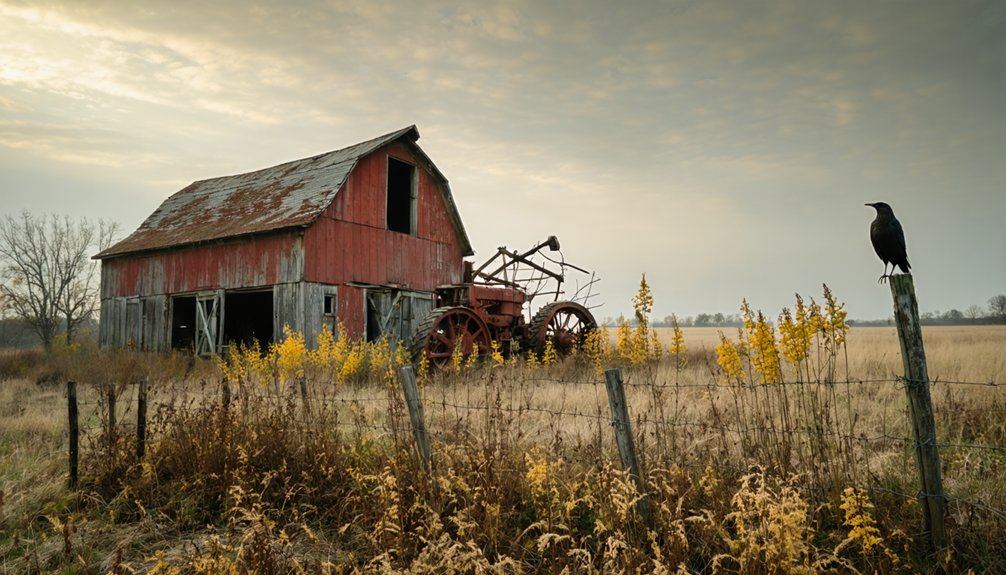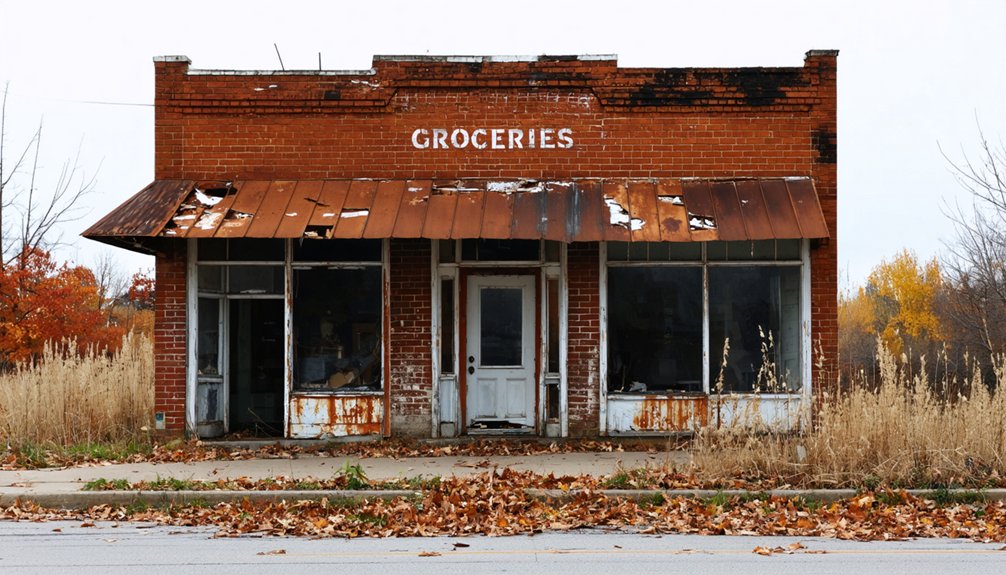You’ll find Mount Pisgah’s remains near Thayer, Iowa, where Mormon pioneers established an essential waystation in 1846. Nearly 3,000 settlers once lived here, building log homes and farming 1,400 acres of land. The site, now a historic preserve, features a 12-foot obelisk marking the cemetery where up to 800 pioneers rest. Though abandoned by 1852, Mount Pisgah’s dramatic story of survival, sacrifice, and westward migration still echoes across its rolling hills.
Key Takeaways
- Mount Pisgah was established in 1846 as a Mormon pioneer settlement, serving as a crucial waystation between Garden Grove and Council Bluffs.
- The settlement supported 2,000-3,000 residents with extensive farming operations across 1,400 acres before its complete abandonment by 1852.
- High mortality rates claimed between 150-800 lives during its brief existence, with many buried in Iowa’s earliest Mormon cemetery.
- The site transformed into a ghost town after Church leadership called all Midwest Saints to gather in Utah by 1852.
- Today, only a memorial obelisk, reconstructed log cabin, and nine-acre state preserve mark where this thriving pioneer community once stood.
The Birth of a Pioneer Haven
While thousands of Mormon pioneers fled west from Nauvoo, Illinois in 1846, Mount Pisgah emerged as an essential waystation in south-central Iowa.
You’ll find its strategic location among rolling hills overlooking the Grand River, where Apostle Parley P. Pratt recognized its potential as a settlement for struggling emigrants. Like other locations bearing the Mount Pisgah name, this site became a crucial sanctuary for travelers.
Facing pioneer challenges head-on, settlers quickly transformed the landscape into a thriving community. They built log homes, meetinghouses, and farms to sustain those who couldn’t continue westward. Brigham Young described the challenging conditions as a great mud hole during the spring settlement.
Mormon pioneers carved civilization from wilderness, creating shelters and farms to support fellow travelers on their westward journey.
The community’s resilience showed in their rapid development of thousands of acres for crops like corn, beans, potatoes, and pumpkins.
Mount Pisgah’s establishment demonstrated remarkable foresight, providing a critical haven between Garden Grove and Council Bluffs where disadvantaged travelers could rest, resupply, and rebuild their strength for the journey ahead.
Life and Survival in the Settlement
Life at Mount Pisgah tested the pioneers’ resolve through every harsh season. You’d find survival strategies woven into every aspect of daily life, from the strategic placement of hillside cabins to the cultivation of diverse crops across thousands of acres.
The settlement’s community resilience showed in their ability to feed 2,000-3,000 residents through locally grown food, despite widespread illness and limited resources.
In the face of staggering mortality rates that claimed between 150-800 lives, the settlers maintained their social bonds through religious gatherings in two log meetinghouses.
The 12-foot-high obelisk now stands as a lasting tribute to those who perished at the settlement.
They’d work together, farming multiple crops including peas, corn, beans, and pumpkins within their 1,400-acre fenced enclosure.
Even when the U.S. Army recruited volunteers for the Mormon Battalion, the community persevered until their eventual departure in 1852.
The Sacred Ground: Mount Pisgah Cemetery
As a confirmation to the pioneers’ struggles and faith, Mount Pisgah Cemetery stands as one of Iowa’s earliest Mormon burial grounds, containing the remains of up to 800 settlers who perished between 1846-1852.
You’ll find this sacred acre on the west slope of Pisgah hill, marked by a 12-foot obelisk that embodies the pioneers’ endurance. The monument’s symbolism reflects their westward journey through:
- Indiana marble construction weighing 4,200 pounds
- Limestone and Italian marble base blocks
- Inscriptions honoring those who died from 1846-1848
- Strategic placement overlooking promising prairie lands
While many original headstones have succumbed to time and weather, burial practices of the era spread beyond the main acre. The settlers initially sought shelter in pioneer caves until proper log cabins could be constructed.
Today, you can visit this historic preserve near Thayer, Iowa, where a reconstructed log cabin adds to the site’s educational value.
Military Service and Community Support
During the summer of 1846, U.S. Army Captain James Allen arrived at Mount Pisgah seeking recruits for the Mexican-American War. While initial recruitment efforts faltered, he found success at Council Bluffs where nearly 500 men enlisted in what became the Mormon Battalion. Their military motivations included earning wages and the promise of discharge in California, where many hoped to build new homes. Each soldier received $42 for clothing to equip themselves for the journey.
Despite losing essential manpower, Mount Pisgah’s community resilience shone through. You’ll find evidence of their determination in the settlement’s continued growth, as remaining residents managed thousands of acres of crops and operated significant workshops. The second company encampment at Mount Pisgah maintained approximately three thousand strong members.
The community sustained both local needs and supported passing emigrants, even as the battalion marched 2,000 miles westward. Their sacrifice and industriousness kept this vital waypoint functioning during a pivotal time in Mormon migration.
The Final Days and Abandonment
By 1852, you’d find Mount Pisgah‘s remaining residents facing a decisive moment when Church leadership called all Midwest Saints to gather in Utah.
You’d witness families selling their land and improvements to local settlers as they prepared for the final leg of their journey west.
Within six years of the settlement’s founding, you’d see Mount Pisgah completely empty, with only the cemetery remaining as evidence to those who’d lived and died there.
Church Orders Migration West
The Church’s leadership enacted a decisive plan to abandon Mount Pisgah in the early 1850s, reflecting broader organizational changes within the Mormon migration west. The migration dynamics shifted as Utah Territory became established, making way stations less essential for the journey.
Under Brigham Young’s direction, you’d find these key elements of community consolidation:
- Saints were instructed to sell their properties to frontier settlers
- Coordinated wagon trains moved residents in organized groups
- Rescue companies assisted those lacking resources
- Migration timing aligned with seasonal grass growth for livestock
The settlement, which once housed up to 2,000 residents, gradually emptied as families headed west. This marked the end of Mount Pisgah’s role as a vital waypoint in the Mormon migration story, though its cemetery remained as evidence to the challenges faced.
Last Pioneer Families Leave
As Brigham Young’s final call for gathering to Utah echoed across the Midwest in 1852, Mount Pisgah’s remaining pioneer families began their bittersweet departure from the settlement they’d inhabited since 1846.
You’d have witnessed the last residents packing their wagons, leaving behind makeshift homes and untended farmland that once sustained their community.
The pioneer memories were especially poignant as families said goodbye to the cemetery where nearly 150 of their loved ones lay buried, including children and respected leaders like William Huntington.
The twelve-foot obelisk monument stands today as a silent sentinel commemorating those who never completed their westward journey.
Despite the heartache, strong community bonds helped them face the challenging journey ahead. They’d endured harsh weather, illness, and limited provisions together, and now they’d unite one final time in their westward trek to Utah, marking the end of Mount Pisgah’s role in Mormon Trail history.
Legacy and Historic Preservation
While Mount Pisgah‘s original structures have long since vanished, significant preservation efforts have transformed this historic Mormon Trail site into an important memorial and educational destination.
The legacy impact of this temporary settlement lives on through dedicated preservation work, despite the preservation challenges of maintaining a 19th-century site. The site’s location on the Mormon Trail made it a crucial waypoint for pioneers traveling from Illinois to Utah.
Today, you’ll find these key elements at Mount Pisgah:
- A striking 12-foot obelisk monument erected in 1888, marking the LDS Church’s first historical landmark
- A nine-acre state preserve featuring interpretive exhibits and markers
- A reconstructed log cabin built in 1996 by the Des Moines Iowa Stake
- The cemetery, which serves as a poignant reminder of pioneer sacrifice, containing up to 300 graves
These preserved features help tell the story of Mormon pioneers who demonstrated remarkable resilience during their westward migration.
Frequently Asked Questions
What Was the Primary Source of Water for Mount Pisgah Settlers?
Like a lifeline from the earth, your settlement’s sustainability came from a massive natural spring gushing from the hillside, which served as the primary water source for all daily needs.
Were There Any Native American Interactions With the Mount Pisgah Settlement?
You’ll find that Native American relations with Mount Pisgah settlers were particularly peaceful. Chief Pied Riche welcomed the Mormons, recognizing their shared experience of displacement, which led to amicable settlement relations.
How Did Settlers Communicate With Other Mormon Settlements During This Period?
You’d rely on letters carried by horseback messengers between settlements, since telegraph lines and postal services weren’t established yet. Church leaders and traders helped maintain essential communication links along the Mormon Trail.
What Happened to the Original Buildings After the Settlement Was Abandoned?
You won’t find any original abandoned structures today – they weren’t historically preserved. Most buildings were dismantled or decayed naturally after settlers left in 1852, leaving only cemetery grounds and archaeological traces.
Did Any Non-Mormon Pioneers or Travelers Stay at Mount Pisgah?
While you’d expect to find records of non-Mormon settlers at this major waypoint, historical travelers who weren’t Mormon rarely stayed at Mount Pisgah, as it served primarily as their exclusive settlement.
References
- https://history.churchofjesuschrist.org/content/historic-sites/iowa/remembering-mount-pisgah-iowa?lang=eng
- https://history.churchofjesuschrist.org/subsection/historic-sites/iowa/thayer/mount-pisgah-monument
- https://www.youtube.com/watch?v=pm7C8XXh_bE
- https://www.thechurchnews.com/1998/11/28/23249728/spotlight-on-historical-sites-mt-pisgah-iowa/
- https://en.wikipedia.org/wiki/Mount_Pisgah
- https://byustudies.byu.edu/article/the-closedown-of-lds-iowa-settlements-in-1852-that-completed-the-nauvoo-exodus-and-jampacked-the-mormon-trail
- https://www.iowadnr.gov/places-go/state-preserves/mount-pisgah-cemetery-state-preserve
- https://familypedia.fandom.com/wiki/Mount_Pisgah_Monument
- https://www.nps.gov/mopi/planyourvisit/mount-pisgah.htm
- https://history.churchofjesuschrist.org/content/trek/mount-pisgah?lang=eng



